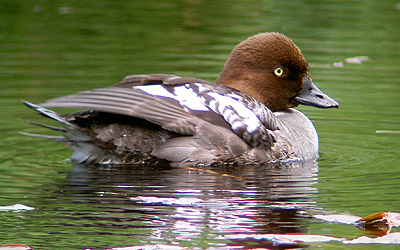Common Goldeneye (Knipa)


Characteristics:
The Common Goldeneye is a medium-sized diving duck (length 40–48 cm) with a compact body and large head.
- Male: Striking black-and-white plumage with a dark green iridescent head and a distinct round white spot at the base of the bill. The breast is white and the back black.
- Female: Brown head, grey body, and white underparts.
Both sexes have pale yellow eyes and a short, strong bill.
When flying, the wings make a distinct whistling sound, earning it the nickname “whistler duck.”
Habitat:
The goldeneye breeds across most of Sweden, from Skåne in the south to Lapland in the north, but is most common in forested regions with clear lakes and calm rivers. During migration and winter, it is often seen along coastal waters and larger inland lakes.
Behaviour:
The goldeneye is a diving duck, often seen diving for food below the surface. It is monogamous during the breeding season and nests mainly in tree cavities, particularly old black woodpecker holes, or in nest boxes provided by humans.
Remarkably, the ducklings leave the nest within a day after hatching, leaping bravely from high tree holes straight down to the water.
Diet:
The goldeneye feeds mainly on small fish, crustaceans, mussels, snails, and aquatic insect larvae. In summer it consumes more insects; in winter, fish dominates its diet.
Reproduction:
Breeding takes place in April–May. The female lays 6–12 eggs, which she incubates for about 30 days. The ducklings are precocial — they leave the nest immediately and find their own food while being guarded by the female.
Migration:
The goldeneye is a partial migrant. Many birds overwinter in southern Sweden, along the west coast and in Denmark, while northern populations migrate to the Baltic Sea or western Europe.
Distribution:
The species is widespread across northern Europe, Asia, and North America. In Sweden, it is common throughout the country except on Gotland and in the mountain tundra.
Hunting:
The goldeneye is a game bird and may be hunted in Sweden from 21 august to 31 January (check local regulations). It is mainly hunted during coastal and lake hunts when flocks gather in autumn and winter.
Firearm class (Sweden):
Hunting is conducted with a shotgun, typically using pellet size no. 4–6.
Think for the hunting exam:
- Diving duck with white cheek spot (male) and whistling wings in flight.
- Nests in tree holes or nest boxes.
- Feeds on fish, crustaceans, and aquatic insects.
- Ducklings jump from the nest soon after hatching.
- Common across Swedish lakes and coasts.
- Hunted with shotgun, classic waterfowl hunting species.
